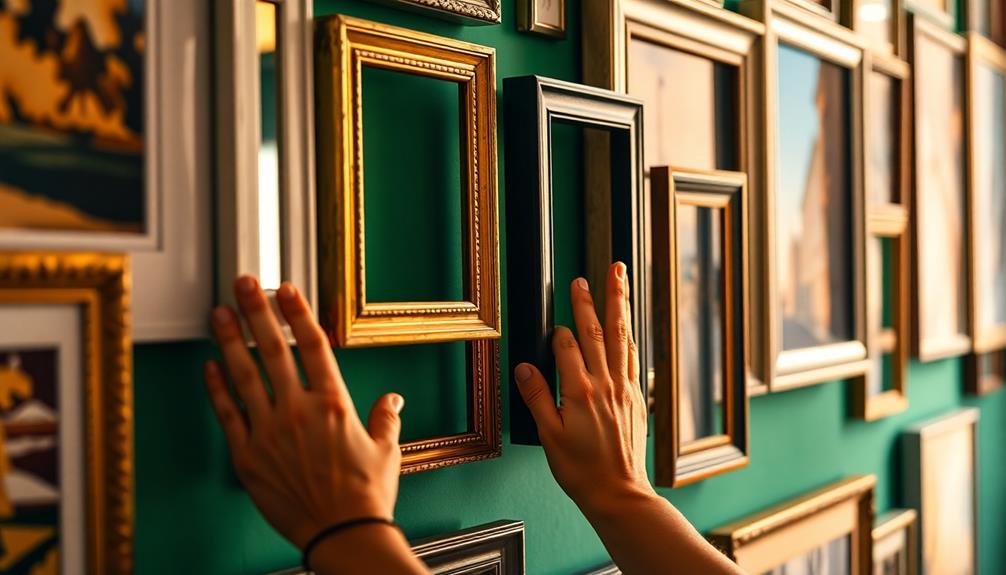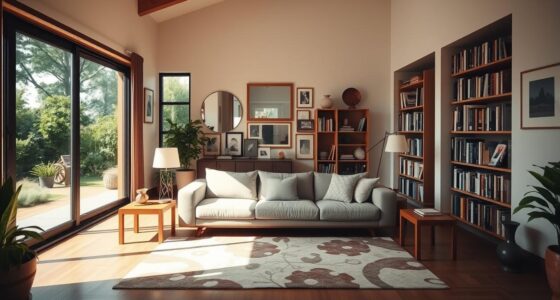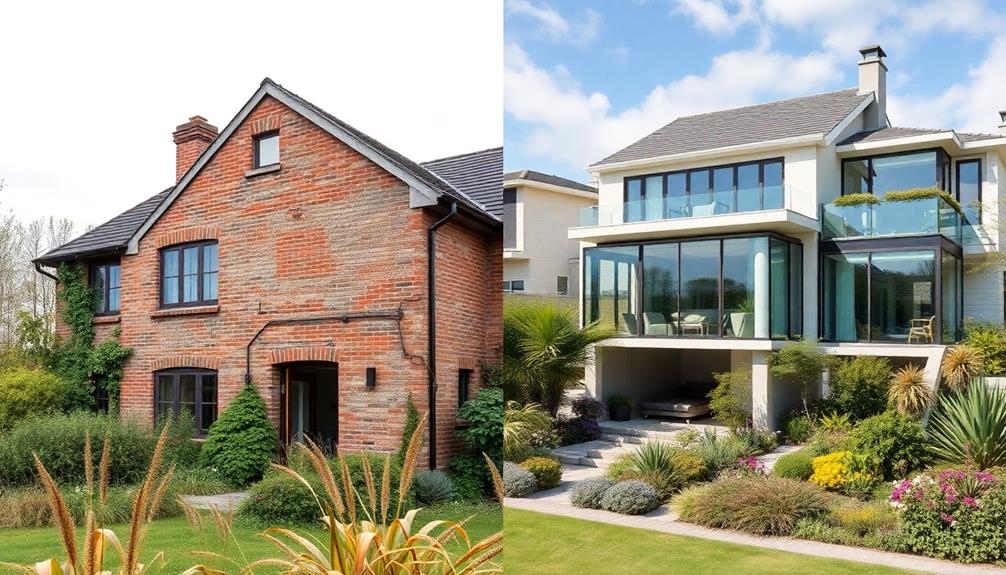To master the art of hanging frames, start by measuring your wall space and marking a center point for your display. Choose a location that draws the eye, like above a piece of furniture, and consider the overall aesthetic. Use the right hardware for your frame's weight, ensuring stability. Attach hangers securely, like D-rings, and double-check your alignment with a level. Clean your wall surface for a good bond if you're using Command strips. Finally, step back and adjust for perfect spacing. There's plenty more to discover about creating a gallery wall that stands out beautifully.
Key Takeaways
- Measure wall dimensions and mark the center point for precise frame placement, ensuring optimal visibility and alignment.
- Select appropriate hanging hardware based on frame weight and wall material for secure attachment.
- Use a level to ensure frames hang straight, adjusting as needed for visual balance.
- Clean the wall surface thoroughly to create a secure foundation for hanging frames.
- Consider the overall decor theme and visual arrangement for a cohesive, professional appearance.
Preparing for Frame Placement
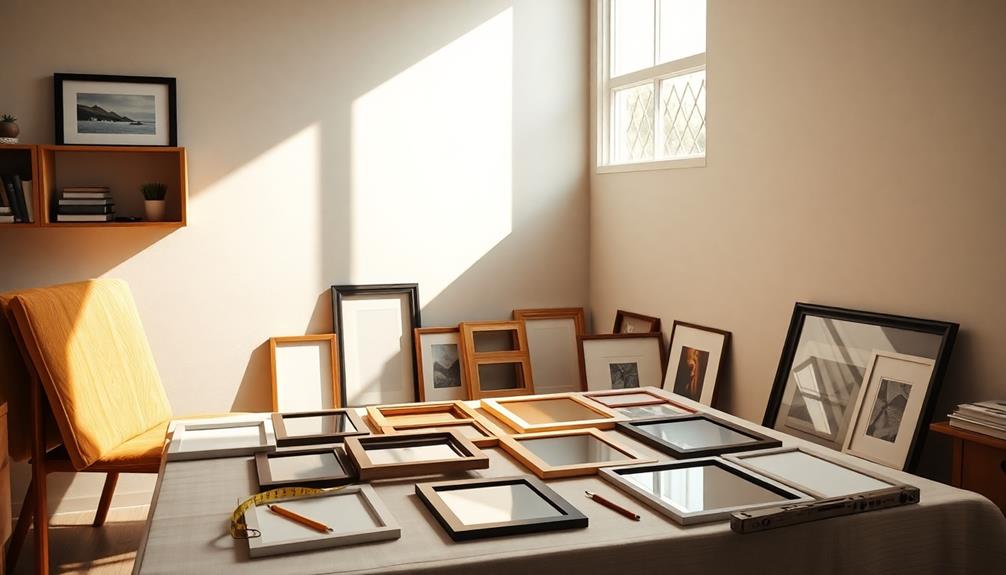
When it comes to creating an eye-catching display, preparation is key. Start by measuring your wall space and marking the center point for frame placement. This will help you visualize the layout and arrangement of your frames.
Consider how the frames will complement the overall aesthetic of the room—think about colors, styles, and themes, especially if you're incorporating elements from modern farmhouse decor trends. Use appropriate hanging hardware to guarantee proper frame alignment, and make certain to evenly space and align each frame for a professional appearance.
Cleaning the wall surface beforehand is essential; remove any dust or dirt to guarantee a secure attachment. With these steps, you're well on your way to a stunning display that draws attention and enhances your space.
Selecting the Right Wall Location

Choosing the right wall location for your frames can make all the difference in your display's impact. Start by measuring your wall dimensions to identify the best spot for your artwork.
Look for areas that naturally draw attention, like above furniture or in entryways. Consider room aesthetics; your frames should complement the overall decor and color scheme. Incorporating the principles of mood boards essential can help you visualize how your frames will fit within the space.
Think about the arrangement you want—symmetrical arrangements often create a more formal look, while asymmetrical ones feel more casual and dynamic. Visualize your layout before making any marks on the wall, and mark the center point to guide your placement.
Taking these steps guarantees your frames enhance the space effectively, creating a mesmerizing visual experience.
Measuring and Marking Techniques

Accurate measuring and marking techniques are essential for achieving a polished frame display. Start by measuring the wall space where you plan to hang your frames. Use a tape measure to determine the height and width, and mark your center point with a pencil. This reference point will guide your layout.
Effective keyword optimization can also enhance your overall presentation by guaranteeing your frame arrangement captures attention. Next, decide on your arrangement—whether symmetrical or asymmetrical—and visualize it before marking any additional spots.
Once you have your frame placements, use a level to guarantee each frame will hang straight. Mark where your nails or hooks will go, being careful to avoid extra holes. Double-check your measurements to maintain alignment and aesthetics, guaranteeing a professional look in your display.
Preparing the Wall Surface

A clean wall surface is essential for guaranteeing your frames hang securely and look their best. Before you start, grab a microfiber cloth to wipe away any dust or dirt.
If your walls have heavier dust buildup, use a vacuum with a soft brush attachment. For stains, mix mild soap with warm water, and gently spot clean the area.
This prep work not only enhances the appearance of your frames but also guarantees that any adhesives or hardware you use stick properly.
Once the wall is clean, take a moment to gather any adhesive materials you might need, like wall anchors or double-sided tape, to secure your frames effectively.
This solid foundation will make hanging your frames a breeze!
Choosing Hanging Hardware
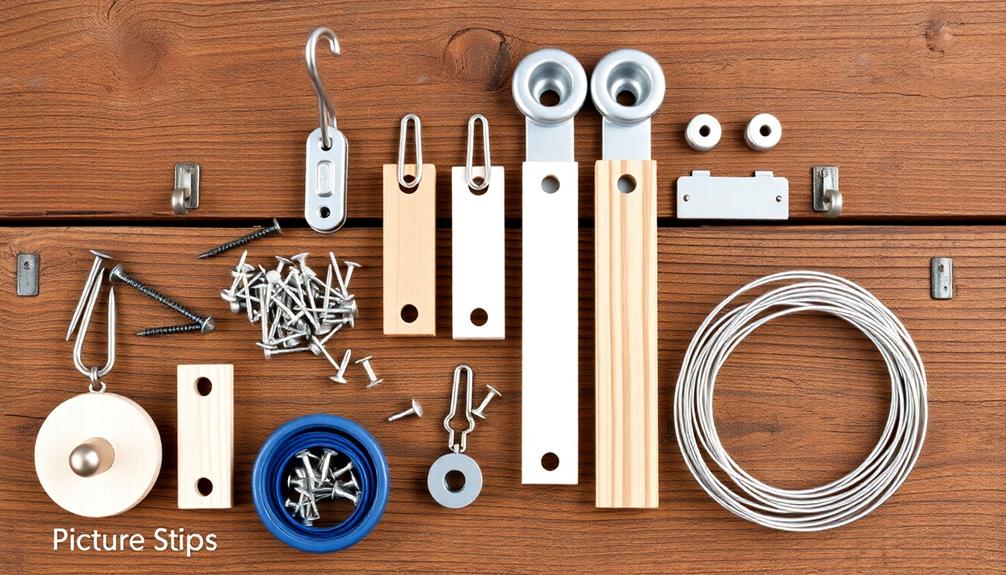
After preparing your wall surface, the next step involves selecting the right hanging hardware for your frames. The choice of hardware considerably affects the stability and appearance of your display. Consider the weight of your frames and the wall's material when selecting hardware.
Here's a quick reference table to help you decide:
| Frame Weight | Recommended Hardware | Notes |
|---|---|---|
| Lightweight (<5 lbs) | Adhesive Hooks | No nails needed |
| Medium (5-15 lbs) | Picture Wire & Hooks | Confirm hooks are secure |
| Heavy (>15 lbs) | Picture Hanging Hooks | Use appropriate anchors |
Attaching D-Rings and Hangers

Attaching D-rings and hangers is an essential step for ensuring your frames hang securely and look great.
Start by choosing the right type of hanger; D-rings are a popular choice for their reliability. Position the D-rings on the back of the frame, roughly one-third down from the top for ideal balance. Use a screwdriver to attach them with screws, making sure they're secure.
For added stability, consider using sawtooth hangers, which are easy to install and provide a strong grip on the wall. Once your hangers are in place, double-check their alignment, ensuring they'll sit evenly on your wall hook or nail.
This simple process sets the stage for a polished and professional-looking display.
Using Wire and Cords

Using wire and cords for frame hanging offers versatility and stability, making it a popular choice among decorators. You can easily adjust the height and angle of your frames, allowing for a personalized display.
To start, attach picture wire to the back of your frame using D-rings or screws. Confirm it's taut but not overly tight. When hanging, use wall hooks or nails that can support the weight of your frame.
If you prefer a more casual look, consider using decorative cords that add character. This method's flexibility makes it simple to rearrange frames whenever you want a fresh look.
Just remember to check the frame's stability after hanging to confirm it's secure and safe.
Employing Command Strips

When it comes to hanging frames, Command strips offer a hassle-free solution that many people appreciate. They eliminate the need for nails and the potential for wall damage, making them perfect for renters or anyone seeking a simple installation.
Here's how to use them effectively:
- Choose the right strips: Select strips rated for your frame's weight for secure hanging.
- Prepare the wall: Clean the surface with rubbing alcohol to guarantee a strong bond.
- Apply and press: Stick the strips on both the frame and wall, pressing firmly for about 30 seconds.
Leveling and Adjusting Frames
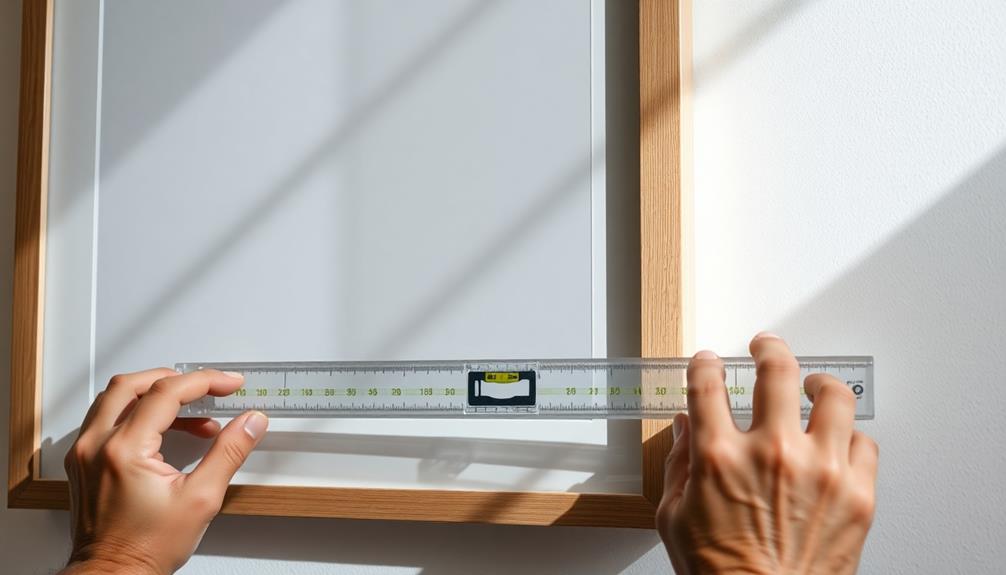
For a polished and professional look, leveling and adjusting frames is essential. Start by using a level to guarantee your frame sits straight. Mark the desired height and spacing on the wall with a pencil, creating a clear guide.
Hold the frame against the wall, checking the level as you adjust its position. Don't forget to maintain consistent spacing between multiple frames for visual harmony; this creates a cohesive display. If you notice any misalignment, simply adjust the frame until it's perfect.
After securing your frames, step back to evaluate their overall look. A little time spent leveling and adjusting can make all the difference in achieving an aesthetically pleasing arrangement that enhances your space.
Future Trends in Home Decor
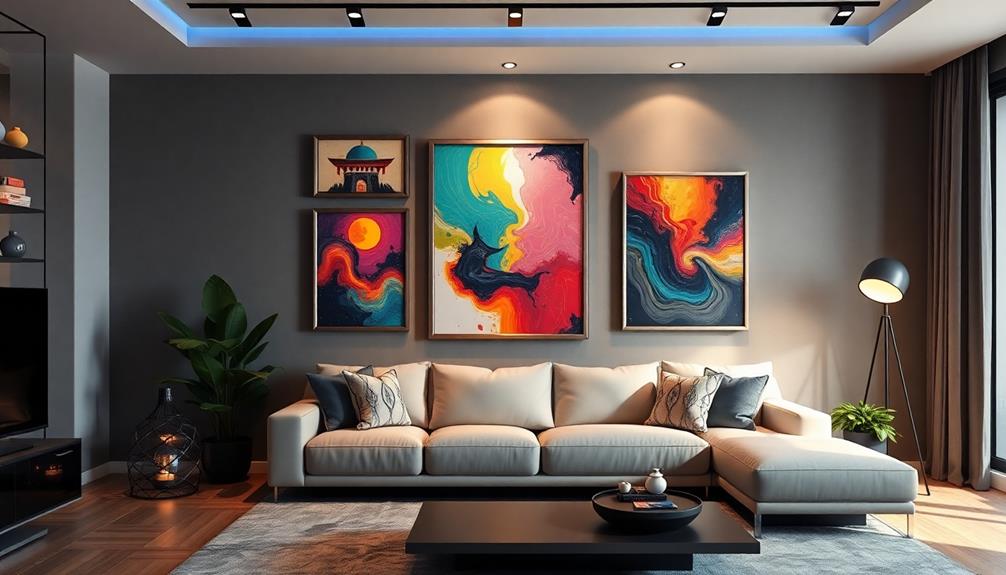
The future of home decor is rapidly evolving, with innovative designs and smart technology taking center stage. You can expect to see:
- Tech-integrated furniture: Items like adjustable desks and multifunctional coffee tables that enhance your living spaces.
- Sustainable materials: Eco-friendly options that not only look good but also promote a healthier planet.
- Smart home systems: Voice-controlled lighting and temperature systems that add convenience and efficiency to your daily life.
These trends not only elevate the aesthetic of your home but also prioritize wellness and sustainability.
Frequently Asked Questions
What Types of Frames Are Best for Different Room Styles?
When choosing frames for various room styles, consider sleek metal frames for modern spaces, rustic wood for farmhouse aesthetics, and ornate styles for traditional decor. Match colors and textures to enhance your room's overall vibe.
Can I Hang Frames on Textured or Uneven Walls?
Hanging frames on textured or uneven walls is like traversing a rocky path; it can be tricky. Use adhesive hooks or wall anchors for stability, ensuring your art stays secure and looks great despite imperfections.
How Do I Remove Frames Without Damaging the Wall?
To remove frames without damaging the wall, gently slide a putty knife or your fingers behind the frame to loosen it. Pull slowly while supporting the frame to prevent sudden movement that could cause damage.
What Are Creative Ways to Arrange Multiple Frames?
You can arrange multiple frames creatively by mixing different sizes and orientations. Try a gallery wall for a dynamic look, or create a linear arrangement for a sleek appearance. Experiment with colors and themes for added interest.
How Often Should I Update My Wall Art Display?
You should update your wall art display every season or whenever you feel inspired. This keeps your space fresh and reflects your evolving taste. Don't hesitate to change it up whenever you want!
Conclusion
Now that you've got the tools and techniques to hang frames like a pro, think of your walls as a blank canvas waiting for your unique masterpiece. With each carefully placed frame, you're not just decorating; you're telling your story and creating a warm embrace for your memories. Embrace your creativity and let your walls reflect who you are. So, grab your hammer and let's turn those empty spaces into a vibrant gallery that sparks joy every day!
